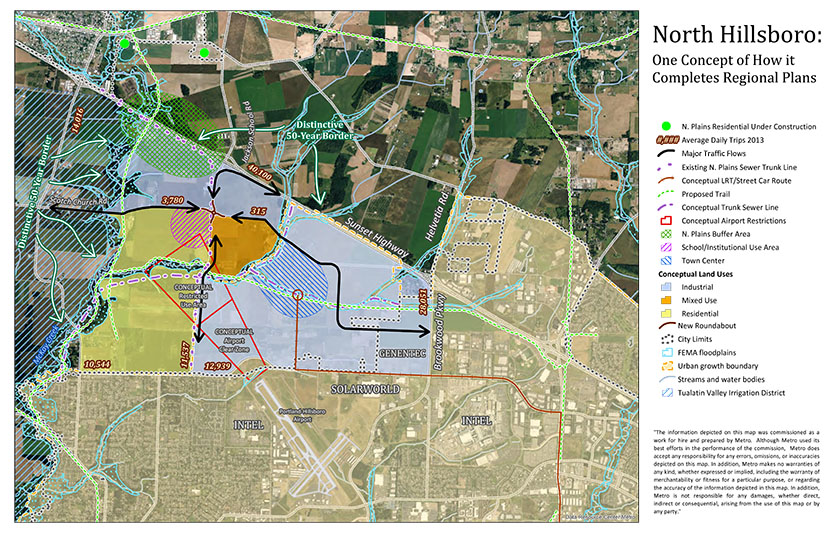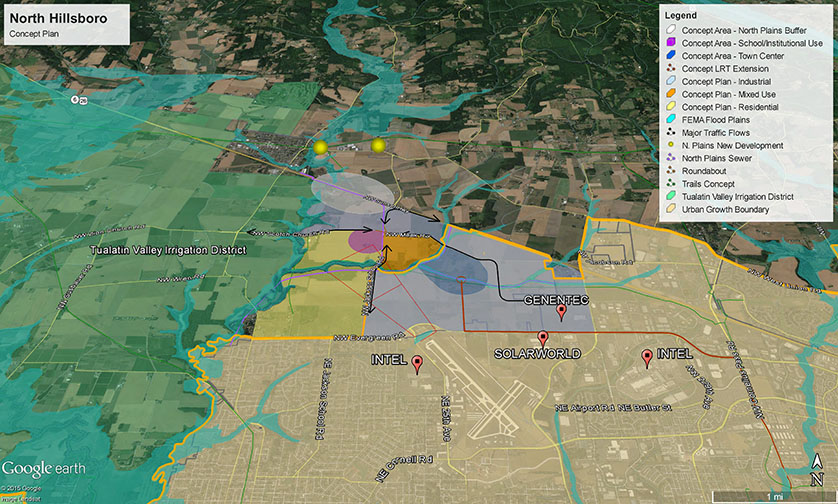Northwest Hillsboro
ALLIANCE
Advocating Common Sense Land Use
One Concept Plan for Northwest Hillsboro
This map depicts one of many “concept” plans for the long range development of NWH. This map is truly one of many options. The emphasis here is to envision both how well NWH fits into the current UGB and how it could augment many of the Region’s “compact” development objectives. It also provides some insight as to the synergy that could be achieved by including the larger NWH area and the inefficiencies associated with the current UGB.

Land Use Concept... Creating a "Great Community"
The “plan” provides for a full mix of urban uses that support the Region’s and the State’s most promising industrial area. All of the NWH Concept Planning area is literally a stone’s throw distant from Intel’s largest establishment as well as Genentec, Solar World and many other promising businesses. By bringing in all of NWH into the urban reserve the necessary critical mass can be achieved to create the “scale” required to establish a “great community” that is not possible with small incremental Urban Reserve corrections that may occur in the future. This larger scale urban planning creates the size needed for: orderly infrastructure provision, logical additions to the UGB as needed, and the mass necessary for high quality transit service. Metro had it right when it included all of the area south of the Sunset Highway and east of McKay Creek.
High Quality Transit
This “concept plan” provides for a higher density urban “town center” characterized by a mix of high density residential, office, and commercial land uses. This “town center” could be located on land that is currently highly parcelized, is developed as rural residential; and, is unlikely to convert to industrial or low density residential uses. By creating the high density “town center” the plan makes possible the orderly conversion of difficult to convert rural residential land and the “anchoring” of a major transit oriented development terminal. By creating this transit termination location the “plan” encourages the extension of a high capacity transit connection to the Westside MAX line. This line would terminate at the “town center” and serve important trip generators like Intel, Genentec, and Solar World in route. Currently transit service to these existing trip generators lacks quality service to the MAX line.
Institutional Opportunities
Whether development occurs in North Hillsboro, as proposed in this “concept plan”, or in North Plains and other parts of Hillsboro, there will be a significant need for public institutional land. NH could be planned to incorporate a new high school, middle and grade school, and other related civic uses. These uses could be planned to better fit the adjacent land uses and thereby avoid the placement of large schools and other government functions in industrial areas (Liberty High School) is in the middle of an industrial area.
Hillsboro Airport
Currently the Airport’s flight path traverses open agricultural land. The recent addition to the UGB will require reconsideration of the zoning and potential development of this property. Beyond the UGB significant property is affected by the flight path. Recently, the Port of Portland completed a tree inventory of incursion into the flight path that is on agricultural land outside the UGB. Should all of NWH be included the urban reserve a logical consideration of how this land should treated in the long term could be accomplished in the “concept plan”. It seems fitting that urban land make accommodation for airport considerations. Conversely, restricting agricultural uses to accommodate urban uses could be avoided should NWH be designated UR. In this fashion proper zoning and protection of this critical urban oriented “airport” use could be accomplished.
Arterial Road Impacts
Jackson School Rd. is a busy urban arterial serving much of the existing Hillsboro. It serves as a critical access route to the Sunset Highway. Similarly, Scotch Church Rd. serves as the primary connection to the Sunset for the large volume of trips originating in Cornelius and Forest Grove. Meek Rd. is being realigned on its east end at Brookwood Blvd. and serves as alternative connection to the Sunset via Jackson School Rd. These arterials will be even more important to the region’s premier industrial area by the recent expansion (2014 Legislature) of the UGB in the immediate area. Additionally, there are significant upgrades underway by Washington County to this route that recognizes both existing traffic demand and future traffic demand. The intersection of Jackson School Rd., Meek Rd., and Scotch Church Rd., will be realigned by the implementation of a traffic circle in 2015. Traffic forecasts post implementation of this 2015 traffic circle improvement indicate significant increases in travel demand on all three of these arterials. Inclusion of NWH in the urban reserve would negate the very significant hazardous and long term impacts these “urban” arterials are causing to the adjacent farmland.
Sewer Service
Clean Water Services (CWS) emphasizes the advantages of “gravity” sewer service over pressure lines that require pumping stations. “Gravity” systems are more reliable, less costly, and easier to maintain. Much of NH that is now inside the UGB will not be able to be served by gravity sewer…it will need to be pumped. The NWH area (south of the Sunset) included in the Metro Urban Reserve area can all be easily served by “gravity” sewer to a “long term” pump station at North Hillsboro’s S.W. corner. By including all of North Hillsboro in Urban Reserve CWS can avoid the potentiality of having to move the primary pump station as logical Urban Reserve and Urban Growth Boundary changes occur in future years.
Distinctive Boundaries
The current Northwest Hillsboro UGB/Rural Reserve boundary is arguably not a “real” boundary. The north edge uses a tributary of Waible Creek (which is a tributary of McKay Creek) as its 50 year separation between “rural” and “urban” uses. This tributary is hardly more than a ditch and has no discernible flood plain; and, thereby no clear and distinctive separation between these conflicting land uses. The “original” Metro boundary for the NH Urban Reserve is in fact far more distinctive with large a geographic separation associated with the McKay Creek floodplain and the grade separated four lane Sunset Highway.
Trail Systems
Including all of NWH in an UR would provide for a complete trail system, using the natural drainage corridors of McKay and Waible Creeks that could connect the existing Hillsboro urban community with the regional trail system envisioned on the RxR right of way running east and west through North Plains. Additionally, the important regional recreational facilities in and around Hillsboro Stadium and Faber Field could be connected by trails to the broader local and regional trail system.
Interface Area
The residents of the Metro area currently enjoy the clear visual separation of urban land from agricultural land as they travel the Sunset corridor. The “original” Metro UR boundary provided the opportunity to define an “interface” area in NH that continues this visual separation and would cause Hillsboro and Metro to undertake dialogue with the City of North Plains as to how both sides of the Sunset should be planned. Without this impetus it is possible that North Plains will fully develop to the Sunset Highway on the Highway’s northern edge.
The Market
Regardless of government’s land use decisions the “market” forces will continue. The Region and the State have hugely invested in the existing NH industrial area. It is now the home of some of the State’s largest and most promising employers. The high paid employees of these companies will continue to create an unrelenting demand for a full range of supporting urban land uses including residential, institutional, and commercial uses. Some of this demand can reasonably be absorbed in other parts of the existing UGB. But, some of this demand, if not met in NH, will simply move to the nearest and low cost opportunity area. Should a larger opportunity to meet this demand not be provided in NH it will be met outside the contiguous Metro UGB in North Plains, Banks, and or Columbia County.
Jurisdictional Capacity
NWH is attached to the highly functional City of Hillsboro. Hillsboro has a proven record of creative land use planning and infrastructure provision. Together with Metro, Washington County, Clean Water Services, the State of Oregon, and the broader development community, NWH could become a special place without the costs and subsidies required in locations requiring redevelopment. The land patterns and the efficiencies of infrastructure provision in NWH make for a market driven, low cost, non-subsidized and logical addition to the metropolitan urban fabric.
The Numbers
How is it that Metro can spend three years aligning the amount of UR land with the best notion of the 50-year demand and then have the Legislature reduce the size of the UR significantly in the very place in the region of highest demand? The UR as adopted by Metro provided an UR that was 11% bigger for a population that is estimated to be 75% bigger. Of all of the locations where the UR could be reduced without significant market dysfunction and lost “great community” opportunity NWH was not it.
According to Oregon’s Office of Economic Analysis, Washington County is forecast to grow from 543,000 in population in 2010 to 921,000 in population by 2040. This 69% increase will make Washington County the largest county in population in Oregon and represents a much faster growth rate than either Multnomah or Clackamas counties.
“Great Communities”: an Opportunity Lost
The Region has for sometime been emphasizing the creation of “great communities” that are characterized by a range of land use types that are combined in such a way that induces community. They are envisioned as being supportive of transit, walking and bicycling and aesthetically attractive. At this point in time nearly all of the attention given to the creation of such places has been in places that are fully occupied by existing businesses and buildings. These heavily parcelized footprints make moving to more synergistic “great communities” exceedingly difficult. To realistically accomplish this vision of more compact and integrated communities most often requires significant government intervention and financial support…like using “urban renewal” authority. NWH, as provided for in the Metro UR decision, offers a very real “great community” opportunity. Here the pallet is clear, without government subsidy, for government and the private sector to collaborate in accomplishing an original and unique special place. If NWH stays “as is” no “great community” opportunity will be possible. The current geography lacks the scale and the mixture of land uses needed to create a “great community”. The NH UR as established by Metro embodied the scale and other prerequisites needed for such consideration.
IMAGINE…Someplace special like perhaps never before possible in Oregon. Since establishing the Oregon land use system in 1973 the Region has not had an opportunity equivalent to NWH. For the most part the Region has been infilling the area included in the original UGB with little consideration for a new large scale “great community” started from scratch. Now with the expectation of nearly 380,000 people in Washington county by 2040 (25 years from now not 50) it makes total sense to create a new highly functional addition to the UR and in time the UGB.
Making “Rural Reserve” Workable
One of the primary objectives of S.B. 1011 was not only to provide long-range certainty for what could be considered for urbanization; but also, to provide the agricultural community with certainty of what land would remain in agricultural use. For the most part owners of agricultural land in NWH have little regard for the “rural reserve” designation and will not likely make long-range agriculture related investments. The thinking is Metro got it right and the Legislature got it wrong. In short the “rural reserve” designation applied by the Legislature is being disregarded by North Hillsboro land owners.
